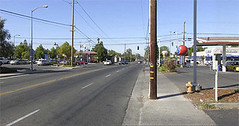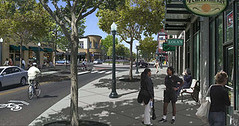Fighting for the status quo, or not

The Wall Street Journal article online includes a slide show showing simulations by Urban Advantage of how to improve often dismal streetscapes in ways that promote livability. The original photo of the intersection of Hurley Way and Fulton Avenue, east of downtown Sacramento, shows a narrow sidewalk, streetfront parking lots, poorly marked crosswalks and no protection from the sun. Sacramento Area Council of Governments, Urban Advantage.
The comments in yesterday's entry mention how hundreds have comments have been posted to the Washington Post article, "Drivers Feeling Shunned by D.C.." Yes it is likely that the commenters favor the car. I am not going to read the comments either (and for the most part, except for commenters to blogs like this one, BeyondDC, Washcycle, or Bacon's Rebellion (the comments still bug me but at least they are erudite) I don't read comments because too often they are foolish.
But it's interesting to contrast the Post article about rebuilding the pedestrian orientation of our road infrastructure--which is really about neighborhood-based livability more than anything--to today's front page article in the Wall Street Journal, "With Gas Over $4, Cities Explore Whether It's Smart to Be Dense: Sacramento's 'Blueprint' for Growth Draws National Attention."
DC is a national model already. L'Enfant saw to that. All we are doing is trying to further strengthen the characteristics that support optimal mobility.
The articles are about the same issue, but the take is so much different.

Clearer crosswalks, wider sidewalks, bike lanes and streetlamps make for a safer pedestrian experience. Trees bring needed shade. Storefronts replace parking lots along the side of the road.
DC should not be a car sewer for anyone, residents or nonresidents.
There is a great publication, about 4 or 5 years old, about transit oriented development, published by DC Office of Planning, Trans-Formation: Recreating Transit-Oriented Neighborhood Centers in Washington, DC. It lays out the principles of livability, not just transit. For years I have lamented that the introductory text of this report hasn't been converted into large sized boards and trotted around to the various public meetings, used in presentations to ANCs, etc.
It's true that we can't expect nonresidents to advocate for livable neighborhoods in DC. But there is no excuse for residents to promote automobility.
Another really good report on the same general topic is the Restore the Core report by the DC chapter of the Sierra Club. It's going to be revised over the course of the next year. Seeing this report back in 2000 really shaped my own involvement in these issues. (Which is why I am committed to helping to produce a new edition.)
The Washington Post has an odd agenda. It's based in the city, and intimately involved with the powers-that-be who run the city. At the same time, it has more subscribers outside of the city than within it (DC is only the #4 market for the Post, and Post leadership believes that many of the office-based subscriptions further serve suburbanites rather than city dwellers). This shapes the paper's coverage and priorities, and means that promoting suburbanite automobility plays an important part in Post editorial writing.
One example is how the Post is strongly in favor of the Inter County Connector, while the Baltimore Sun, seeing the impact of this project on State of Maryland transportation funding and priorities overall, was not in favor.
Labels: neighborhood-based transportation planning, sustainable land use and resource planning, urban design/placemaking



0 Comments:
Post a Comment
<< Home